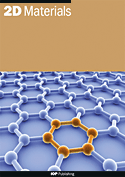
2D Materials
Scope & Guideline
Pioneering Discoveries in 2D Material Technologies
Introduction
Aims and Scopes
- Synthesis and Characterization of 2D Materials:
The journal emphasizes innovative methods for synthesizing various two-dimensional materials, including transition metal dichalcogenides, graphene, and MXenes. It also covers advanced characterization techniques such as spectroscopy and microscopy to elucidate the structural and electronic properties of these materials. - Applications in Electronics and Optoelectronics:
Research articles often explore the integration of 2D materials into electronic devices, such as transistors, sensors, and photodetectors, highlighting their unique electrical properties and potential for miniaturization and enhanced performance. - Energy Storage and Conversion Technologies:
A significant focus is placed on the development of 2D materials for energy applications, including batteries, supercapacitors, and photocatalysis. The journal discusses how these materials can improve energy efficiency and sustainability. - Theoretical and Computational Studies:
The journal includes contributions that utilize theoretical models and computational simulations to predict the properties and behaviors of 2D materials, providing insights that guide experimental research. - Interfacial Phenomena and Heterostructures:
Research on the interactions and properties at the interfaces of 2D materials and heterostructures is a key area of interest, particularly in understanding their collective behaviors and emergent phenomena.
Trending and Emerging
- Hybrid and Composite Materials:
There is a growing trend towards the development of hybrid and composite materials that combine 2D materials with other substances to enhance performance in various applications, such as catalysis and energy storage. - Machine Learning and Artificial Intelligence Applications:
The integration of machine learning and AI techniques in the discovery and optimization of 2D materials is on the rise. This trend is facilitating faster material development and improved predictive capabilities. - Twistronics and Moiré Superlattices:
Research into twistronics, which focuses on the effects of twisting angles in bilayer and multilayer systems, is emerging as a significant area of interest for manipulating electronic properties and creating novel behaviors. - Valleytronics and Spintronics:
Studies exploring valleytronic and spintronic applications of 2D materials are gaining momentum, driven by their potential for next-generation information technologies. - Sustainability and Environmental Applications:
There is an increasing emphasis on the sustainable production and application of 2D materials, particularly in environmental remediation and energy-efficient technologies.
Declining or Waning
- Traditional Bulk Materials:
There has been a noticeable decline in studies focusing on traditional bulk materials compared to the rapidly advancing field of 2D materials. Researchers are increasingly concentrating on the unique properties of 2D materials rather than reverting to bulk counterparts. - Single-Dimensional Materials:
Research on single-dimensional materials, such as nanowires and nanotubes, has decreased as the focus shifts towards the more versatile and application-rich domain of 2D materials. The unique properties and scalability of 2D materials make them more favorable for current applications. - Basic Characterization Studies:
There is a diminishing trend in publications that solely focus on basic characterization studies of 2D materials without exploring their applications or implications. The community appears to favor studies that tie characterization directly to functional applications. - Conventional Energy Applications:
The exploration of conventional energy materials and systems has lessened, as researchers are now more inclined to investigate innovative solutions using 2D materials for energy applications, such as advanced batteries and catalysts.
Similar Journals
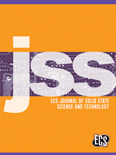
ECS Journal of Solid State Science and Technology
Advancing the Frontiers of Solid State ResearchECS Journal of Solid State Science and Technology, published by the Electrochemical Society, is a prominent journal dedicated to the advancement of research in the field of electronic, optical, and magnetic materials. With an ISSN of 2162-8769 and an E-ISSN of 2162-8777, this journal has established a significant presence since its inception in 2012, spanning critical developments in solid-state science that are essential for innovative technologies. Operating within the United States and recognized for its global outreach, it holds a respectable Q3 category ranking in the materials science category as of 2023, reflecting its commitment to high-quality research and its role in bridging theoretical and applied aspects of materials science. Researchers, professionals, and students alike will find vital information and cutting-edge studies that further the understanding and applications of solid-state technologies. The journal is accessible to an extensive audience, making it an invaluable resource for those engaged in the ever-evolving landscape of materials science.
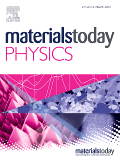
Materials Today Physics
Pioneering Discoveries in Physics and Sustainable TechnologiesMaterials Today Physics, published by Elsevier, is a prestigious journal that focuses on the interdisciplinary field of materials science, physics, and energy innovations. With an impressive impact factor and a Q1 ranking in three categories—Energy (miscellaneous), Materials Science (miscellaneous), and Physics and Astronomy (miscellaneous)—it stands out as a key platform for disseminating high-quality research. The journal, which has been in circulation since 2017, provides a vital resource for academics and industry professionals alike, facilitating the exchange of knowledge and driving advancements in materials research. Available in both traditional and open-access formats, Materials Today Physics aims to publish cutting-edge research articles that push the boundaries of material properties and their applications, thereby contributing to the development of sustainable technologies and energy solutions. With a commitment to excellence, this journal offers a robust avenue for researchers to share their findings with a global audience, making it an essential tool for those engaged in the rapidly evolving fields of physics and materials science.
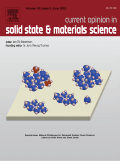
CURRENT OPINION IN SOLID STATE & MATERIALS SCIENCE
Advancing knowledge in solid-state science.CURRENT OPINION IN SOLID STATE & MATERIALS SCIENCE, published by Pergamon-Elsevier Science Ltd, is a premier journal in the field of materials science that offers critical insights into the latest advancements and trends in solid-state materials. With an impressive impact factor and a 2023 ranking in the top quartile (Q1) for materials science, this journal provides a platform for researchers, professionals, and students to explore and disseminate high-quality research findings. The journal covers a broad range of topics, encouraging interdisciplinary dialogue among scientists and engineers. While currently not available as open access, its rigorous selection process ensures that only the most impactful and relevant studies are published. Since its inception, CURRENT OPINION IN SOLID STATE & MATERIALS SCIENCE has established itself as an essential resource for anyone involved in the field, facilitating the rapid exchange of knowledge that is vital for advancing material innovations.

Optoelectronics and Advanced Materials-Rapid Communications
Transforming Ideas into Impactful Research in Optoelectronics.Optoelectronics and Advanced Materials-Rapid Communications is a pivotal journal in the field of optoelectronics, specializing in the rapid dissemination of original research and reviews concerning advanced materials and their applications. Published by the NATL INST OPTOELECTRONICS in Romania, this journal has been instrumental for researchers and professionals since its inception in 2008. With an E-ISSN of 2065-3824, it offers a platform for innovative studies across various disciplines, focusing on both theoretical and practical advancements in electrical and electronic engineering, as well as electronic, optical, and magnetic materials. Although currently categorized in the Q4 quartile based on the 2023 Scopus rankings, the journal is dedicated to enhancing its visibility and citation impact among the scientific community. By facilitating open access to cutting-edge research, Optoelectronics and Advanced Materials-Rapid Communications not only addresses the needs of emerging scholars and industry professionals but also contributes to the broader discourse on materials science. As it continues to evolve through 2024 and beyond, the journal remains an essential resource for those committed to advancing knowledge in optoelectronic technologies.
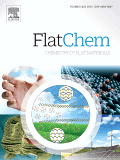
FlatChem
Connecting Researchers to Transformative Material DiscoveriesFlatChem, an esteemed journal published by ELSEVIER, serves as a premier platform for disseminating high-quality research in the dynamic fields of ceramic and composite materials, electronic and optical materials, materials chemistry, and surfaces, coatings, and films. Since its inception in 2017, the journal has garnered a robust reputation, evidenced by its rank in the top quartile (Q1) across multiple categories, including a commendable rank of #25/127 in Ceramics and Composites and #49/284 in Electronic, Optical and Magnetic Materials. With a focus on pioneering advancements and innovative methodologies, FlatChem not only highlights cutting-edge research but also promotes collaboration and knowledge exchange within the scientific community. The journal’s impact is underscored by its impressive rankings in Scopus, marking it as a vital resource for researchers, professionals, and students aiming to stay at the forefront of materials science. As an open-access journal, it ensures that groundbreaking findings are readily accessible, fostering a broader understanding and application of materials innovation worldwide. The journal is based in the Netherlands, with its headquarters located at RADARWEG 29, 1043 NX AMSTERDAM, NETHERLANDS. Join the vibrant community contributing to FlatChem and engage with the forefront of material advancements.
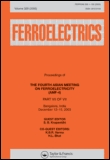
FERROELECTRICS
Fostering Collaboration in Materials ScienceFERROELECTRICS, published by Taylor & Francis Ltd, is a distinguished journal focusing on the multifaceted field of ferroelectric materials and their applications, encompassing aspects of condensed matter physics and electronic, optical, and magnetic materials. Established in 1970 and set to continue through 2024, this journal provides a critical platform for researchers, professionals, and students seeking to explore the latest advancements in ferroelectric phenomena. Although currently categorized in the Q4 quartile in key scientific fields, this journal serves as an invaluable resource for community knowledge sharing and collaboration, despite a competitive landscape evidenced by its Scopus ranks in both related domains. FERROELECTRICS remains committed to fostering innovation and understanding in materials science, providing seamless access to valuable research insights. As this journal continues to evolve, it aims to uplift its standing and broaden its impact in the scientific community.

Journal of Ovonic Research
Pioneering Research in Magnetic and Optical Materials.Journal of Ovonic Research is a distinguished publication dedicated to advancing the fields of electronic, optical, and magnetic materials. Published by VIRTUAL CO PHYSICS SRL, this journal offers a platform for researchers to share innovative findings and developments that push the boundaries of technology and materials science. With an ISSN of 1842-2403 and an E-ISSN of 1584-9953, it provides an important service to the academic community, particularly within Romania and beyond. Despite its recent inception in 2011, the journal has gained traction in the academic landscape, reflecting a Q4 quartile ranking in crucial categories such as Electronic, Optical and Magnetic Materials, as well as in Physics and Astronomy. The Scopus rankings further underscore its positioning, ranking within the 25th to 37th percentile across various disciplines, making it a valuable resource for professionals and students alike. Although the journal currently operates on a non-open access basis, it remains committed to exploring the latest advancements in materials science, encouraging interdisciplinary collaboration and fostering a deeper understanding of surface, coating, and film technologies. As the field evolves, Journal of Ovonic Research stands as a beacon for scholarly communication, bridging the gap between research and practical application.
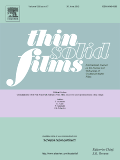
Thin Solid Films
Exploring the Frontiers of Thin Film TechnologyThin Solid Films, published by ELSEVIER SCIENCE SA, is a highly regarded journal in the fields of materials science and physics, specifically focused on the properties and applications of thin films. Established in 1967, this journal has been a leading platform for disseminating research on surfaces, coatings, and advanced materials. With its consistent publication through the notable HIndex of scholarly impact, this journal showcases a diverse range of studies ranging from electronic, optical, and magnetic materials to novel surface and interface engineering. In recent evaluations, Thin Solid Films has achieved significant rankings, including a Q2 position in Materials Chemistry and Metals and Alloys, reflecting its relevance and importance in ongoing scientific discourse. Although it does not offer open access, it provides a vital resource for researchers, professionals, and students seeking to advance their knowledge and expertise in thin film technology. The journal's commitment to quality and innovation makes it an essential publication for anyone engaged in the field.

Inorganic and Nano-Metal Chemistry
Unveiling Breakthroughs in Nano-Metal Applications.Inorganic and Nano-Metal Chemistry is a premier journal published by Taylor & Francis Inc, focusing on innovative research and advancements in the fields of inorganic chemistry and nano-metal applications. With an increasing impact in the academic community, this journal has established itself within the Q3 category of both Inorganic Chemistry and Physical and Theoretical Chemistry as of 2023, reflecting its global recognition and influence. The journal is accessible as an Open Access publication, ensuring that research findings are freely available to a broad audience, promoting transparency and collaboration in scientific exploration. Based in the United Kingdom, Inorganic and Nano-Metal Chemistry aims to disseminate high-quality peer-reviewed articles that not only highlight fundamental studies but also push the boundaries of technological applications in areas such as catalysis, materials science, and nanotechnology. Researchers, professionals, and students will find this journal an invaluable resource for the latest developments and interdisciplinary insights in the ever-evolving landscape of inorganic and nano-metal chemistry.
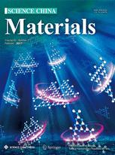
Science China-Materials
Pioneering Research for a Sustainable Tomorrow.Science China-Materials is an esteemed peer-reviewed journal dedicated to advancing the field of materials science, published by SCIENCE PRESS. With a strong focus on innovative research and applications, this journal provides an essential platform for disseminating groundbreaking findings in materials development, characterization, and engineering. Since its inception, Science China-Materials has achieved an impressive Q1 ranking in the Materials Science (miscellaneous) category, reflecting its commitment to quality and the impact of its publications, as indicated by its 86th percentile ranking in Scopus. The journal is set to converge its contributions from 2016 to 2024, making it a vital resource for researchers and professionals interested in the latest advancements and trends in materials science. As an open access publication, it ensures that knowledge is freely available to a global audience, promoting collaboration and innovation across disciplines. The journal is headquartered in Beijing, China, and continues to attract high-quality submissions from leading experts in the field.